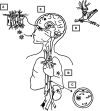Neurologic Manifestations of COVID-19 in Children: Emerging Pathophysiologic Insights
- PMID: 33965992
- PMCID: PMC8240497
- DOI: 10.1097/PCC.0000000000002774
Neurologic Manifestations of COVID-19 in Children: Emerging Pathophysiologic Insights
Conflict of interest statement
The authors have disclosed that they do not have any potential conflicts of interest.
Figures


References
MeSH terms
LinkOut - more resources
Full Text Sources
Other Literature Sources
Medical

